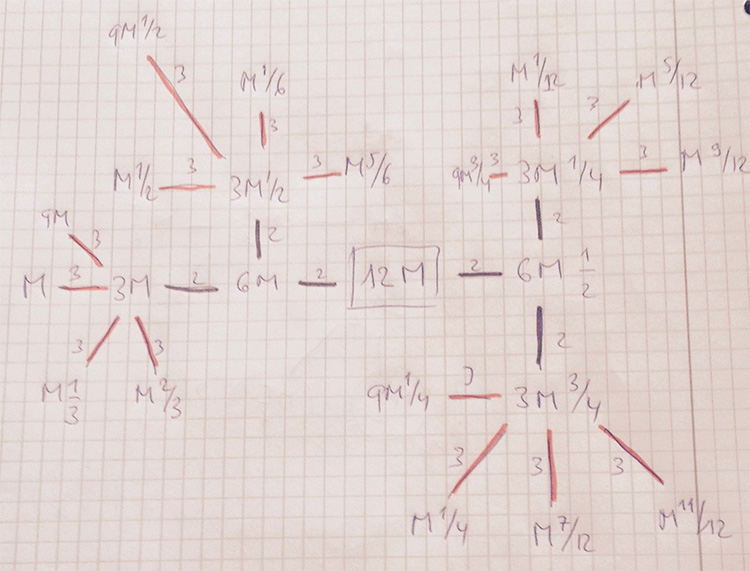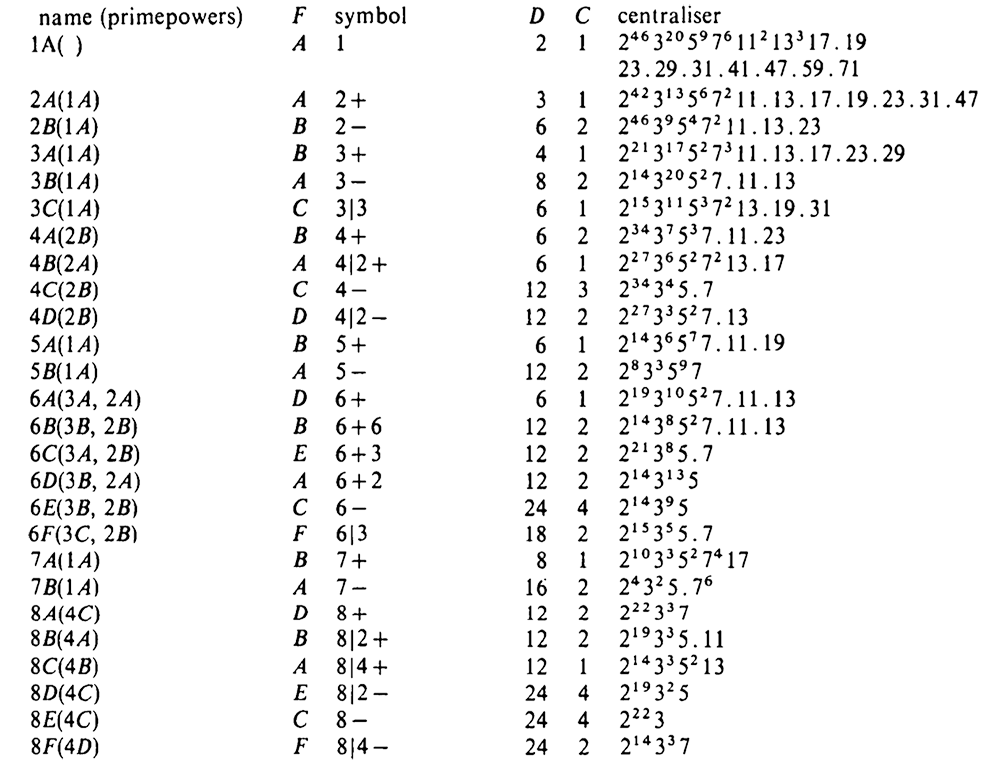Conway introduced his Big Picture to make it easier to understand and name the groups appearing in Monstrous Moonshine.
For $M \in \mathbb{Q}_+$ and $0 \leq \frac{g}{h} < 1$, $M,\frac{g}{h}$ denotes (the projective equivalence class of) the lattice
\[
\mathbb{Z} (M \vec{e}_1 + \frac{g}{h} \vec{e}_2) \oplus \mathbb{Z} \vec{e}_2 \]
which we also like to represent by the $2 \times 2$ matrix
\[
\alpha_{M,\frac{g}{h}} = \begin{bmatrix} M & \frac{g}{h} \\ 0 & 1 \end{bmatrix} \]
A subgroup $G$ of $GL_2(\mathbb{Q})$ is said to fix $M,\frac{g}{h}$ if
\[
\alpha_{M,\frac{g}{h}}.G.\alpha_{M,\frac{g}{h}}^{-1} \subset SL_2(\mathbb{Z}) \]
The full group of all elements fixing $M,\frac{g}{h}$ is the conjugate
\[
\alpha_{M,\frac{g}{h}}^{-1}.SL_2(\mathbb{Z}).\alpha_{M,\frac{g}{h}} \]
For a number lattice $N=N,0$ the elements of this group are all of the form
\[
\begin{bmatrix} a & \frac{b}{N} \\ cN & d \end{bmatrix} \qquad \text{with} \qquad \begin{bmatrix} a & b \\ c & d \end{bmatrix} \in SL_2(\mathbb{Z}) \]
and the intersection with $SL_2(\mathbb{Z})$ (which is the group of all elements fixing the lattice $1=1,0$) is the congruence subgroup
\[
\Gamma_0(N) = \{ \begin{bmatrix} a & b \\ cN & d \end{bmatrix}~|~ad-Nbc = 1 \} \]
Conway argues that this is the real way to think of $\Gamma_0(N)$, as the joint stabilizer of the two lattices $N$ and $1$!
The defining definition of 24 tells us that $\Gamma_0(N)$ fixes more lattices. In fact, it fixes exactly the latices $M \frac{g}{h}$ such that
\[
1~|~M~|~\frac{N}{h^2} \quad \text{with} \quad h^2~|~N \quad \text{and} \quad h~|~24 \]
Conway calls the sub-graph of the Big Picture on these lattices the snake of $(N|1)$.
Here’s the $(60|1)$-snake (note that $60=2^2.3.5$ so $h=1$ or $h=2$ and edges corresponding to the prime $2$ are coloured red, those for $3$ green and for $5$ blue).
\[
\xymatrix{& & & 15 \frac{1}{2} \ar@[red]@{-}[dd] & & \\
& & 5 \frac{1}{2} \ar@[red]@{-}[dd] & & & \\
& 15 \ar@[red]@{-}[rr] \ar@[blue]@{-}[dd] & & 30 \ar@[red]@{-}[rr] \ar@[blue]@{-}[dd] & & 60 \ar@[blue]@{-}[dd] \\
5 \ar@[green]@{-}[ru] \ar@[blue]@{-}[dd] \ar@[red]@{-}[rr] & & 10 \ar@[green]@{-}[ru] \ar@[red]@{-}[rr] \ar@[blue]@{-}[dd] & & 20 \ar@[green]@{-}[ru] \ar@[blue]@{-}[dd] & \\
& 3 \ar@[red]@{-}[rr] & & 6 \ar@[red]@{-}[rr] \ar@[red]@{-}[dd] & & 12 \\
1 \ar@[green]@{-}[ru] \ar@[red]@{-}[rr] & & 2 \ar@[green]@{-}[ru] \ar@[red]@{-}[rr] \ar@[red]@{-}[dd] & & 4 \ar@[green]@{-}[ru] & \\
& & & 3\frac{1}{2} & & \\
& & 1 \frac{1}{2} & & &} \]
The sub-graph of lattices fixed by $\Gamma_0(N)$ for $h=1$, that is all number-lattices $M=M,0$ for $M$ a divisor of $N$ is called the thread of $(N|1)$. Here’s the $(60|1)$-thread
\[
\xymatrix{
& 15 \ar@[red]@{-}[rr] \ar@[blue]@{-}[dd] & & 30 \ar@[red]@{-}[rr] \ar@[blue]@{-}[dd] & & 60 \ar@[blue]@{-}[dd] \\
5 \ar@[green]@{-}[ru] \ar@[blue]@{-}[dd] \ar@[red]@{-}[rr] & & 10 \ar@[green]@{-}[ru] \ar@[red]@{-}[rr] \ar@[blue]@{-}[dd] & & 20 \ar@[green]@{-}[ru] \ar@[blue]@{-}[dd] & \\
& 3 \ar@[red]@{-}[rr] & & 6 \ar@[red]@{-}[rr] & & 12 \\
1 \ar@[green]@{-}[ru] \ar@[red]@{-}[rr] & & 2 \ar@[green]@{-}[ru] \ar@[red]@{-}[rr] & & 4 \ar@[green]@{-}[ru] &
} \]
If $N$ factors as $N = p_1^{e_1} p_2^{e_2} \dots p_k^{e_k}$ then the $(N|1)$-thread is the product of the $(p_i^{e_i}|1)$-threads and has a symmetry group of order $2^k$.
It is generated by $k$ involutions, each one the reflexion in one $(p_i^{e_i}|1)$-thread and the identity on the other $(p_j^{e_j}|1)$-threads.
In the $(60|1)$-thread these are the reflexions in the three mirrors of the figure.
So, there is one involution for every divisor $e$ of $N$ such that $(e,\frac{N}{e})=1$. For such an $e$ there are matrices, with $a,b,c,d \in \mathbb{Z}$, of the form
\[
W_e = \begin{bmatrix} ae & b \\ cN & de \end{bmatrix} \quad \text{with} \quad ade^2-bcN=e \]
Think of Bezout and use that $(e,\frac{N}{e})=1$.
Such $W_e$ normalizes $\Gamma_0(N)$, that is, for any $A \in \Gamma_0(N)$ we have that $W_e.A.W_e^{-1} \in \Gamma_0(N)$. Also, the determinant of $W_e^e$ is equal to $e^2$ so we can write $W_e^2 = e A$ for some $A \in \Gamma_0(N)$.
That is, the transformation $W_e$ (left-multiplication) sends any lattice in the thread or snake of $(N|1)$ to another such lattice (up to projective equivalence) and if we apply $W_e^2$ if fixes each such lattice (again, up to projective equivalence), so it is the desired reflexion corresponding with $e$.
Consider the subgroup of $GL_2(\mathbb{Q})$ generated by $\Gamma_0(N)$ and some of these matrices $W_e,W_f,\dots$ and denote by $\Gamma_0(N)+e,f,\dots$ the quotient modulo positive scalar matrices, then
\[
\Gamma_0(N) \qquad \text{is a normal subgroup of} \qquad \Gamma_0(N)+e,f,\dots \]
with quotient isomorphic to some $(\mathbb{Z}/2\mathbb{Z})^l$ isomorphic to the subgroup generated by the involutions corresponding to $e,f,\dots$.
More generally, consider the $(n|h)$-thread for number lattices $n=n,0$ and $h=h,0$ such that $h | n$ as the sub-graph on all number lattices $l=l,0$ such that $h | l | n$. If we denote with $\Gamma_0(n|h)$ the point-wise stabilizer of $n$ and $h$, then we have that
\[
\Gamma(n|h) = \begin{bmatrix} h & 0 \\ 0 & 1 \end{bmatrix}^{-1}.\Gamma_0(\frac{n}{h}).\begin{bmatrix} h & 0 \\ 0 & 1 \end{bmatrix} \]
and we can then denote with
\[
\Gamma_0(n|h)+e,f,\dots \]
the conjugate of the corresponding group $\Gamma_0(\frac{n}{h})+e,f,\dots$.
If $h$ is the largest divisor of $24$ such that $h^2$ divides $N$, then Conway calls the spine of the $(N|1)$-snake the subgraph on all lattices of the snake whose distance from its periphery is exactly $log(h)$.
For $N=60$, $h=2$ and so the spine of the $(60|1)$-snake is the central piece connected with double black edges
\[
\xymatrix{& & & 15 \frac{1}{2} \ar@[red]@{-}[dd] & & \\
& & 5 \frac{1}{2} \ar@[red]@{-}[dd] & & & \\
& 15 \ar@[red]@{-}[rr] \ar@[blue]@{-}[dd] & & 30 \ar@[red]@{-}[rr] \ar@[black]@{=}[dd] & & 60 \ar@[blue]@{-}[dd] \\
5 \ar@[green]@{-}[ru] \ar@[blue]@{-}[dd] \ar@[red]@{-}[rr] & & 10 \ar@[black]@{=}[ru] \ar@[red]@{-}[rr] \ar@[black]@{=}[dd] & & 20 \ar@[green]@{-}[ru] \ar@[blue]@{-}[dd] & \\
& 3 \ar@[red]@{-}[rr] & & 6 \ar@[red]@{-}[rr] \ar@[red]@{-}[dd] & & 12 \\
1 \ar@[green]@{-}[ru] \ar@[red]@{-}[rr] & & 2 \ar@[black]@{=}[ru] \ar@[red]@{-}[rr] \ar@[red]@{-}[dd] & & 4 \ar@[green]@{-}[ru] & \\
& & & 3\frac{1}{2} & & \\
& & 1 \frac{1}{2} & & &} \]
which is the $(30|2)$-thread.
The upshot of all this is to have a visual proof of the Atkin-Lehner theorem which says that the full normalizer of $\Gamma_0(N)$ is the group $\Gamma_0(\frac{N}{h}|h)+$ (that is, adding all involutions) where $h$ is the largest divisor of $24$ for which $h^2|N$.
Any element of this normalizer must take every lattice in the $(N|1)$-snake fixed by $\Gamma_0(N)$ to another such lattice. Thus it follows that it must take the snake to itself.
Conversely, an element that takes the snake to itself must conjugate into itself the group of all matrices that fix every point of the snake, that is to say, must normalize $\Gamma_0(N)$.
But the elements that take the snake to itself are precisely those that take the spine to itself, and since this spine is just the $(\frac{N}{h}|h)$-thread, this group is just $\Gamma_0(\frac{N}{h}|h)+$.
Reference: J.H. Conway, “Understanding groups like $\Gamma_0(N)$”, in “Groups, Difference Sets, and the Monster”, Walter de Gruyter-Berlin-New York, 1996

